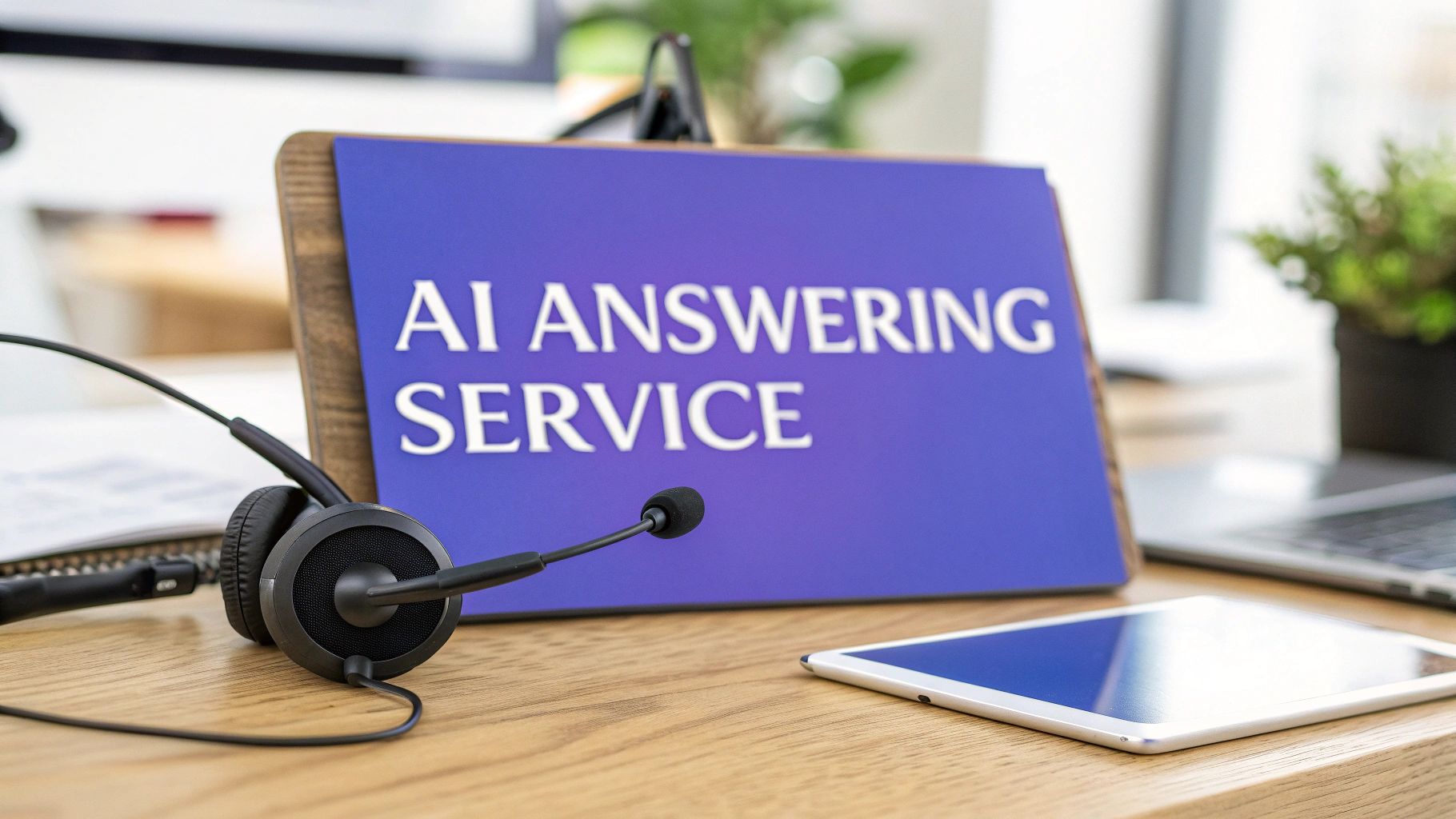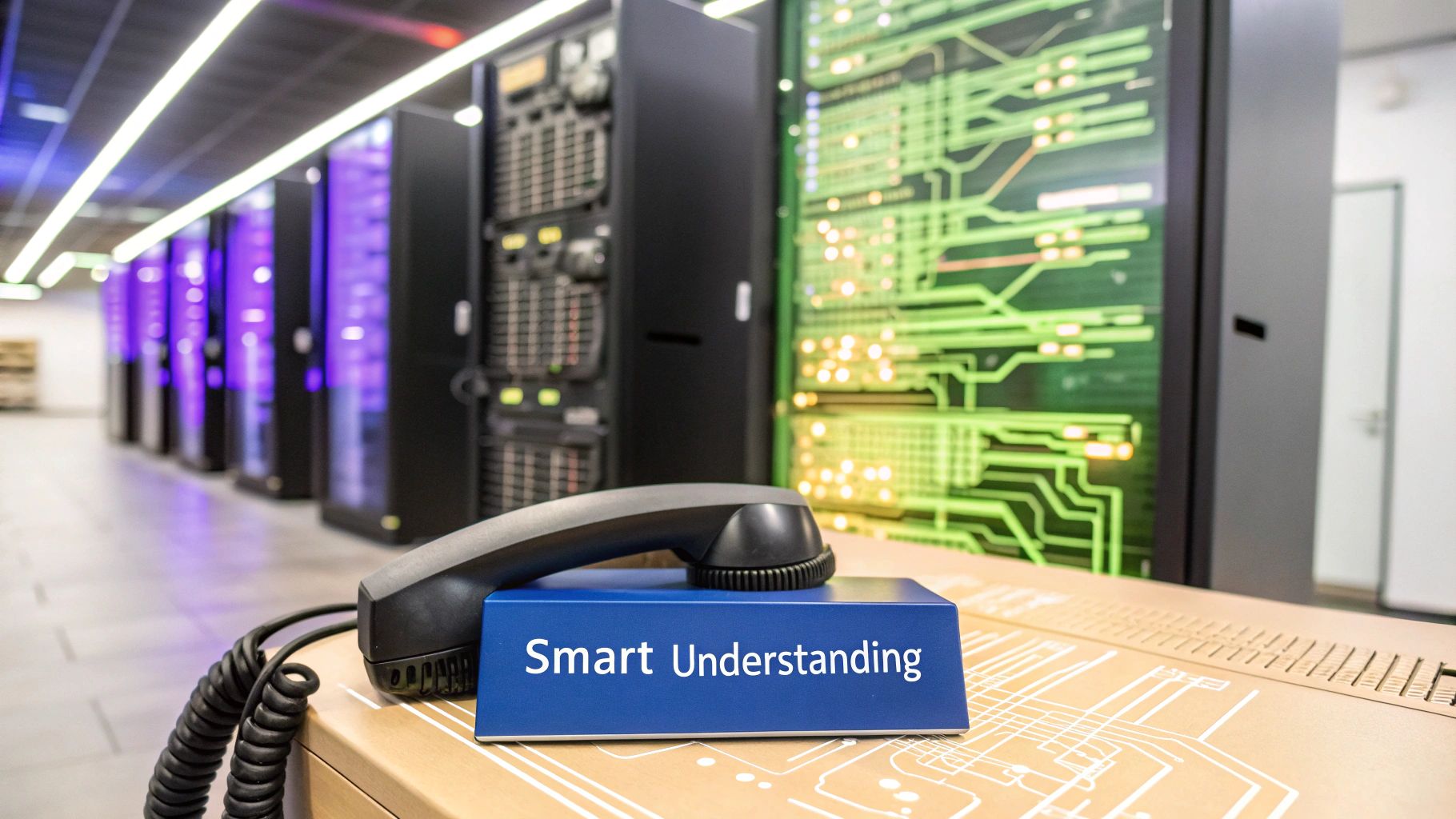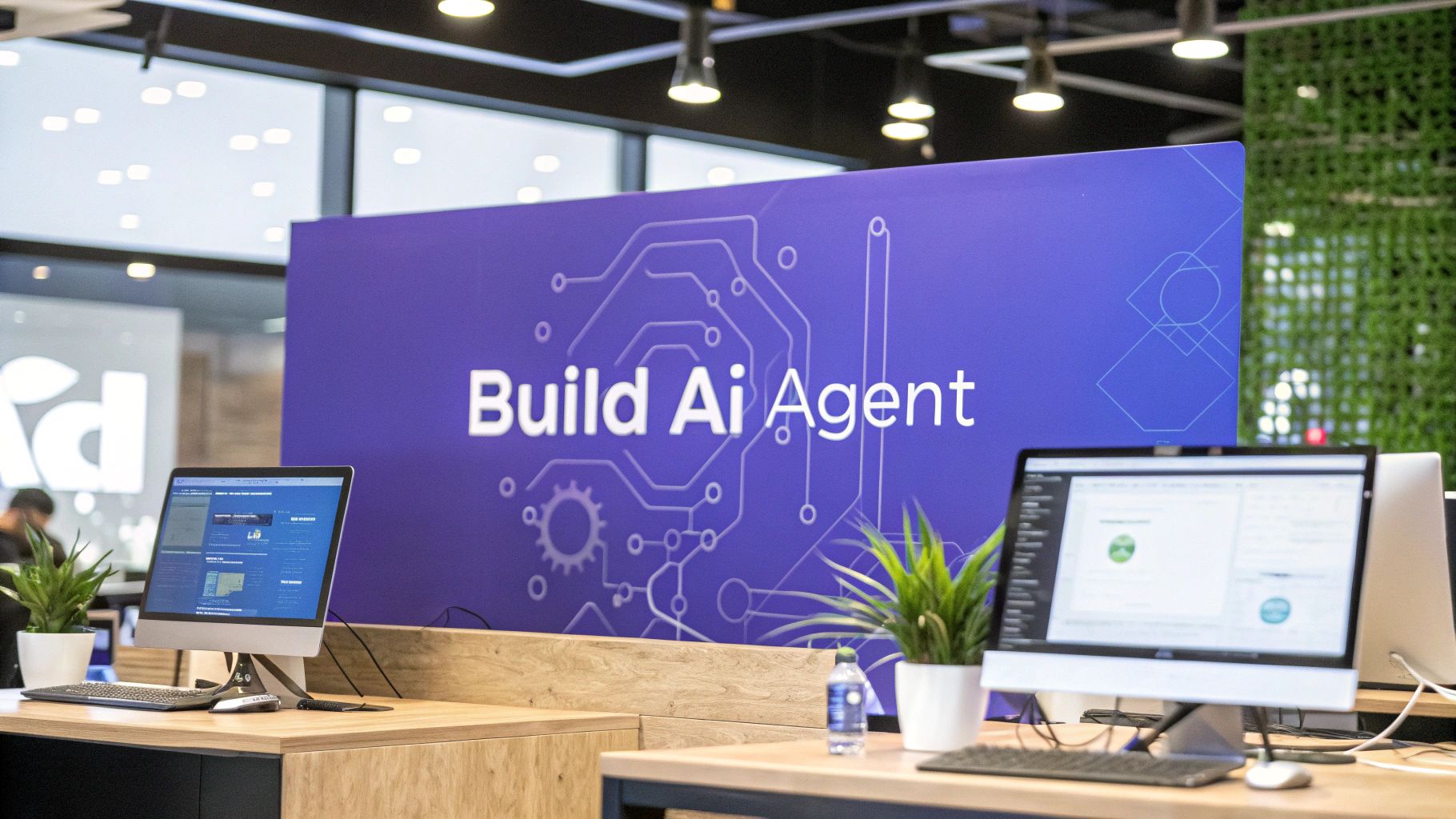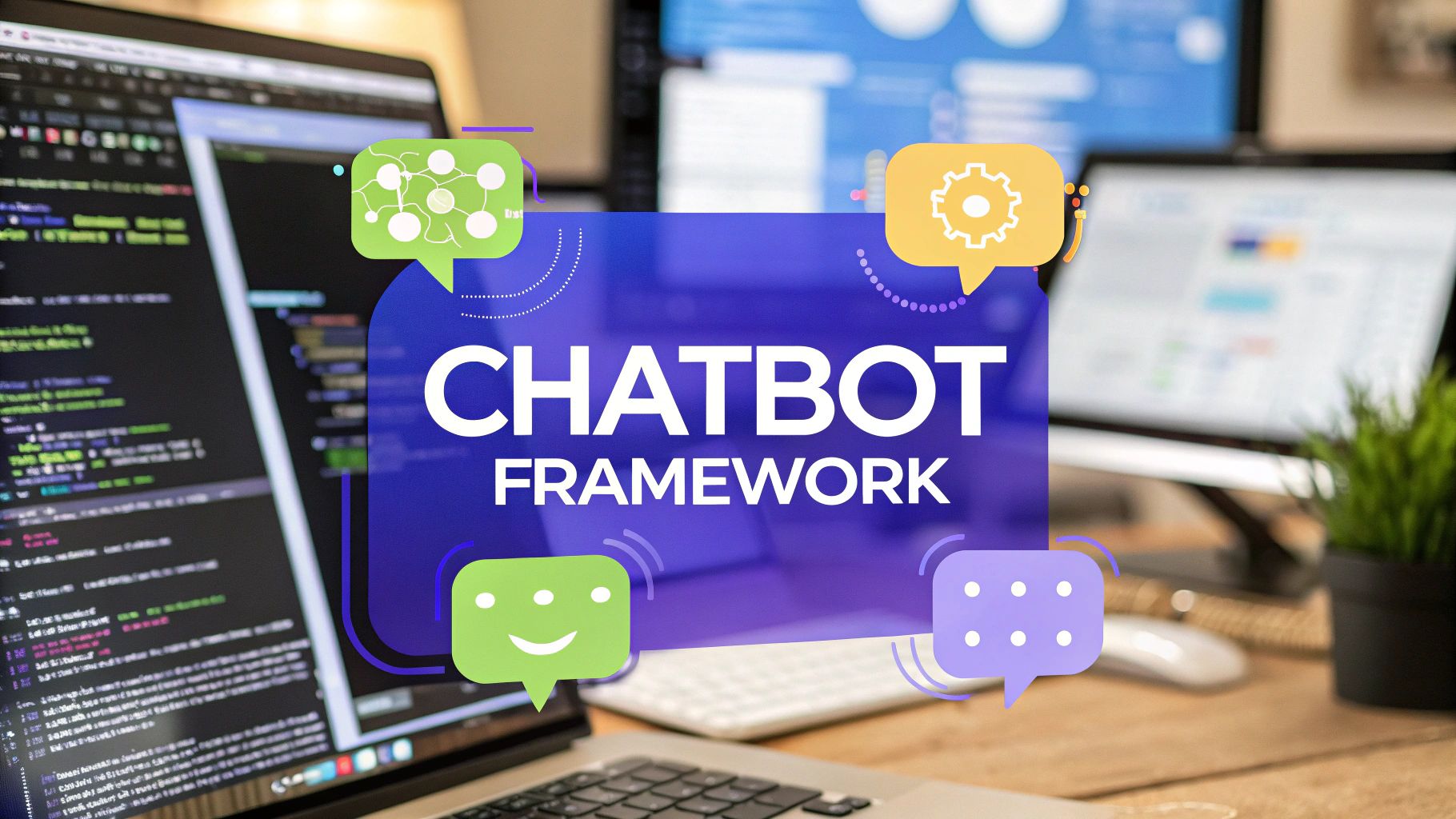AI Answering Service: Boost Customer Support Efficiency
Discover how an AI answering service improves support, saves costs, and enhances customer satisfaction. Learn how to choose the right solution for your business.

Think about the last time you called a business and were sent straight to voicemail. It’s frustrating, right? Now, what if a receptionist picked up instantly, answered your question, and booked an appointment for you, all without missing a beat? That's the promise of an AI answering service.
An AI answering service is an automated system made to handle customer calls and messages without needing a human on the other end. It’s like having a digital receptionist who’s always on, ready to help customers 24/7. This shift to smart automation means businesses can offer immediate support, so no customer ever feels ignored.
What an AI Answering Service Actually Is
Imagine a front-desk person who never takes a sick day, never misses a call, and already knows the answer to 90% of the questions customers ask. That’s the easiest way to think about an AI answering service. It’s a tool built to manage all your incoming communications—phone calls, website chats, even text messages—using technology instead of a live operator.
When a customer reaches out, they’re greeted by a system powered by conversational AI. Instead of a busy signal or a long hold time, they interact with an AI that understands what they need and how to help. (If you want to read more about the tech behind it, our guide on what is conversational AI is a great place to start). This single system can handle an incredible range of tasks that used to require a full-time employee.
Core Functions of AI Answering Services
So, what can these services actually do? A lot more than just take messages. Here are a few of the most valuable functions:
- Instant Responses: The AI answers calls and messages the second they come in, giving every customer a great first impression.
- Appointment Scheduling: It connects directly to your calendar to book, reschedule, or cancel appointments on the fly.
- Lead Capture: The service grabs contact details from potential customers who call after hours, so you never lose a hot lead.
- Smart Call Routing: For complex issues, the AI figures out what the customer needs and transfers the call to the right person or department—no more manual switchboard.
This infographic really puts the differences between an AI service and a traditional human receptionist into perspective, especially when it comes to cost and availability.

The numbers don't lie. AI offers huge cost savings and round-the-clock availability that a human counterpart just can't match. That’s why so many businesses are bringing these tools on board to boost their efficiency and keep customers happy. Subscription plans are pretty flexible, too, typically running anywhere from $50 to over $1,000 per month depending on what a business needs.
For a clearer side-by-side look, this table breaks down the key distinctions between the old way and the new way.
Traditional vs AI Answering Service at a Glance
As you can see, the AI approach offers a much more scalable and cost-effective solution without sacrificing quality.
This technology is a huge part of the broader evolution to AI Customer Service, marking a real shift away from old-school phone systems. It’s all about creating smarter, automated solutions that help businesses of any size operate at their best.
How an AI Answering Service Actually Works
Ever wonder how an AI actually figures out what a customer is saying over the phone? It’s not magic, and the tech behind an AI answering service is probably less complicated than you think. It really boils down to two key ideas working together to create a conversation that feels natural.
The first piece of the puzzle is Natural Language Processing (NLP). The easiest way to think about NLP is to imagine teaching a computer how to read, listen, and understand language like a human. It recognizes words, but it also figures out context, slang, accents, and the real meaning behind a question.
For instance, when a customer says, "I need to move my appointment from tomorrow to next Friday," NLP helps the AI pinpoint the important stuff: "reschedule," "appointment," and the specific dates. That’s how it processes the request without getting confused.

Learning from Every Conversation
The second core component is Machine Learning (ML). This is what makes the AI smarter over time. Think of it like a new receptionist who gets a little better at their job with every single call they handle. ML does the same thing for the AI.
Every interaction feeds the system new data. The AI analyzes what worked, what didn't, and gradually sharpens its responses and its ability to handle tricky situations.
This continuous improvement is a game-changer. A traditional, static phone tree never gets any better. An AI answering service, on the other hand, uses past conversations to improve future ones, which almost always leads to happier customers.
So, when a customer calls, the process is powerful but surprisingly straightforward. NLP deciphers what the customer needs, and the system instantly pulls the right information or kicks off the right action. All the while, the ML component is learning from that interaction to make the next one even smoother.
A Practical Two-Step Process
From a high-level view, the AI follows a simple but effective workflow for every call. This makes sure each customer gets handled quickly and correctly.
- Interpretation and Intent Recognition: First up, the AI uses NLP to listen to what the caller is saying and figure out their goal. Is this person trying to book a service? Check on an order? Just ask for business hours? The AI identifies that main intent in seconds.
- Action and Response Generation: Once the intent is clear, the system gets to work. This could mean digging into a database for information, connecting with a calendar to book an appointment, or—if the question is too complex—routing the call to a human agent.
This whole cycle of understanding and responding happens in a blink. It allows an AI answering service to manage hundreds of calls at once without dropping the ball, turning a simple call-answering system into a problem-solving machine.
Key Features Your Business Needs
When you start looking into AI answering services, it’s easy to think they’re all pretty much the same. While 24/7 availability is a given, the specific features are what separate a basic tool from a genuine operational asset. The right mix of capabilities is what really counts.
First up, look for multi-channel support. Customers don’t just call anymore; they expect to connect via website chat, text messages, and social media. A solid AI service brings all these conversations into one unified platform. This gives your customers a consistent, seamless experience, no matter how they decide to reach out.

Automated Scheduling and Integrations
Another game-changer is automated appointment scheduling. The AI should be able to hook directly into your business calendar, whether you use Google Calendar, Outlook, or something else. This direct sync is huge—it stops double bookings and lets customers schedule meetings on their own time, without any of the email tag your team hates.
Beyond scheduling, a strong CRM integration is a non-negotiable. Connecting your AI to a CRM like HubSpot or Salesforce is incredibly powerful. When a customer calls, the AI can instantly see their entire history—past orders, old support tickets, you name it. That context makes the conversation feel personal and lets the AI solve problems faster, making the customer feel like you actually know who they are.
Analytics for Smarter Decisions
Finally, any AI answering service worth its salt will give you a robust analytics dashboard. This is more than a simple call log; it’s a window into what your customers are really thinking and doing. A good dashboard turns raw data into clear insights that help you make smarter business decisions.
Here’s what you should be able to see at a glance:
- Call Volume Trends: Pinpoint your busiest days and times so you can adjust staffing or marketing campaigns accordingly.
- Common Questions: See what people ask about most often. This is gold for improving your website’s FAQ or training the AI with better responses.
- Resolution Rates: Track how many issues the AI handles solo versus how many get escalated to a human. This helps you gauge its effectiveness.
- Peak Hours: Know exactly when your customers are most active to optimize everything from support availability to sales outreach.
This data is how you spot patterns and fine-tune your entire customer service strategy. It shows you what’s working and, just as importantly, what’s not.
The move to AI-powered customer interactions is happening fast. It’s predicted that by 2025, a staggering 95% of all customer interactions will be handled by AI, marking a massive shift in how businesses operate. As these systems get smarter and more emotionally intelligent, the automated experience will only become more personal and effective.
To look deeper into the stats behind this trend, check out the full data on AI in customer service from Fullview.io.
Real Business Benefits of Using AI
Beyond just fielding calls, an AI answering service delivers real-world results that hit your bottom line and sharpen your operations. This is a core part of your business strategy that adds value in a few key ways.
The most obvious win is significant cost savings. Hiring a team of human receptionists for true 24/7 coverage is expensive. A single AI subscription costs just a fraction of one employee's salary, let alone an entire team. This makes enterprise-level support accessible even for small businesses.

Better Customer Experiences and Higher Satisfaction
Let's be honest: nobody enjoys waiting on hold or wrestling with a confusing phone menu. An AI answering service gets rid of that frustration entirely. Customers get instant answers, book appointments on the spot, and feel heard the moment they reach out.
This immediate attention translates directly into higher customer satisfaction. A positive first interaction sets the tone for the entire relationship. When people get quick, effective help, they’re far more likely to come back and recommend you to others.
There's a reason the market for this tech is exploding. As part of the wider conversational AI market, it's projected to jump from around $12.24 billion in 2024 to an estimated $61.69 billion by 2032. That incredible growth shows just how many businesses are seeing the value in using AI for better, faster communication. You can see a great in-depth analysis of conversational AI's rise by Itransition.com.
Improved Team Efficiency and Focus
Your team’s time is one of your most valuable assets. When they're stuck answering the same repetitive questions all day, they have less time for the work that actually moves the business forward. This is where an AI answering service really shines.
By automating routine inquiries—like questions about business hours, service prices, or appointment availability—the AI clears the path for your staff. This frees them up to focus on solving complex problems, engaging with high-value clients, and handling tasks that require a human touch.
This shift doesn't just boost productivity; it boosts job satisfaction. Employees who get to focus on more meaningful work are more engaged and effective. Automating the simple stuff is a core principle of running a smart operation. You can dig into more ideas on this in our guide to help desk automation.
Ultimately, this lets a small business punch well above its weight, offering stellar support without the high overhead.
Integrating AI With Your Existing Tools
An AI answering service is powerful on its own, but it shouldn't operate in a silo. Its real value is unlocked when you connect it with the business software you already rely on every day. This creates a single, unified system where information flows freely, cutting down on manual data entry and making your entire operation run smoother.
Think about it. Connecting your AI to a CRM like HubSpot or Salesforce is a common first step for a reason. It lets the AI automatically log every customer interaction, creating a complete record without anyone on your team needing to lift a finger. Your sales and support staff will always have the full context of a customer's history, right where they need it.
This screenshot from the Chatiant homepage shows just how central these connections are, highlighting integrations with the platforms businesses use most.
The visual makes it clear: a modern AI platform is built to be a team player, working alongside tools like Slack, Google, and major CRMs.
Creating a Connected Workflow
Beyond just logging calls, an AI answering service can actively manage tasks across different applications. When your AI connects with scheduling software like Calendly, it can book appointments directly into your team’s calendars. This completely eliminates the back-and-forth emails needed to find a time that works for everyone.
You can also link the service to communication platforms such as Slack or Microsoft Teams. A setup like this can send your team real-time notifications for urgent customer issues, new leads captured after hours, or appointments that were just booked.
How Integrations Work
These connections are all made possible through Application Programming Interfaces, or APIs. You can think of an API as a bridge that allows different software programs to talk to each other and share data securely. Building a solid integration strategy is the key to getting the most out of your AI.
To get a better handle on the technical side, you can learn more about how an API for a chatbot works and what it makes possible.
Below is a quick look at some of the most common and valuable software connections you can make.
Common Integration Possibilities
Ultimately, these integrations transform your AI answering service from a simple call-handling tool into the central hub of your customer communication. A platform like Chatiant is designed to make these connections simple, allowing you to build a smarter, more automated business without all the hassle.
Is an AI Answering Service Right for You?
So, is it time to bring an AI answering service into your business?
If your team is drowning in a high volume of the same questions day after day, then it’s a strong contender. The same goes for businesses that want to offer 24/7 support without taking on the high costs of round-the-clock staffing.
An AI service is also a great fit if you're looking to capture leads after hours. This isn't some futuristic idea anymore—it's a practical tool that improves how you talk to customers today. By taking care of the routine stuff, it saves money, keeps customers happy, and frees up your team to focus on the work that really moves the needle.
Think about where automation could slot into your current workflow. If you're missing calls or spending too much time on simple questions, an AI answering service is a logical next step. It's about working smarter, not just harder.
Frequently Asked Questions
Thinking about bringing an AI answering service on board? It's a smart move, but you probably have some practical questions. Here are a few quick answers to the things business owners usually want to know.
How Much Does an AI Answering Service Cost?
The cost for an AI answering service really depends on what you need it to do. For a small business or a startup just getting its feet wet, basic plans can start as low as $50 per month. On the other end, larger companies that handle a ton of calls and need all the bells and whistles might see plans go north of $1,000.
Most providers work on a subscription model. The trick is to look closely at what you get in each tier—things like the number of calls or minutes included, which software it connects with, and how much you can actually tweak the AI's script.
Is an AI Answering Service Hard to Set Up?
Not at all. Most modern AI platforms are designed for regular business owners, not tech wizards. They usually have clean, simple dashboards where you can write out call scripts, set your business hours, and link up your other software without needing to call in an expert.
Plus, many services offer hands-on help to get you through the setup. They’ll walk you through the process to make sure everything is running smoothly from day one.
Can AI Handle Complex Customer Questions?
Yes, but it knows its limits. A well-trained AI can handle a surprisingly broad range of questions, from simple info requests to walking a customer through basic troubleshooting. They really shine when dealing with the same handful of questions that pop up over and over again.
For the truly unique, sensitive, or emotionally charged conversations, a good AI system is smart enough to know when to step aside. It’s designed to pass the call seamlessly to a human agent, so your customer gets the expert help they need without hitting a dead end.
That smooth handoff is the hallmark of a quality service.
What Types of Businesses Benefit the Most?
Just about any business that depends on customer calls can get a lot out of this technology. It’s incredibly versatile and adds real value across a ton of different industries.
- Service-Based Businesses: Think law firms, medical clinics, and contractors. They use AI to book appointments and capture new leads around the clock.
- E-commerce Stores: Online shops use them for 24/7 order status updates and to help customers start a return without waiting for an email reply.
- Small Startups: New companies can project a much bigger, more professional image by making sure every single call gets answered, even when the team is tiny.
At the end of the day, if you need to manage your calls more efficiently, an AI service can probably help.
Ready to see how an AI agent can transform your customer support? Chatiant makes it easy to build and deploy a custom AI trained on your own data. Start for free on Chatiant.com.


